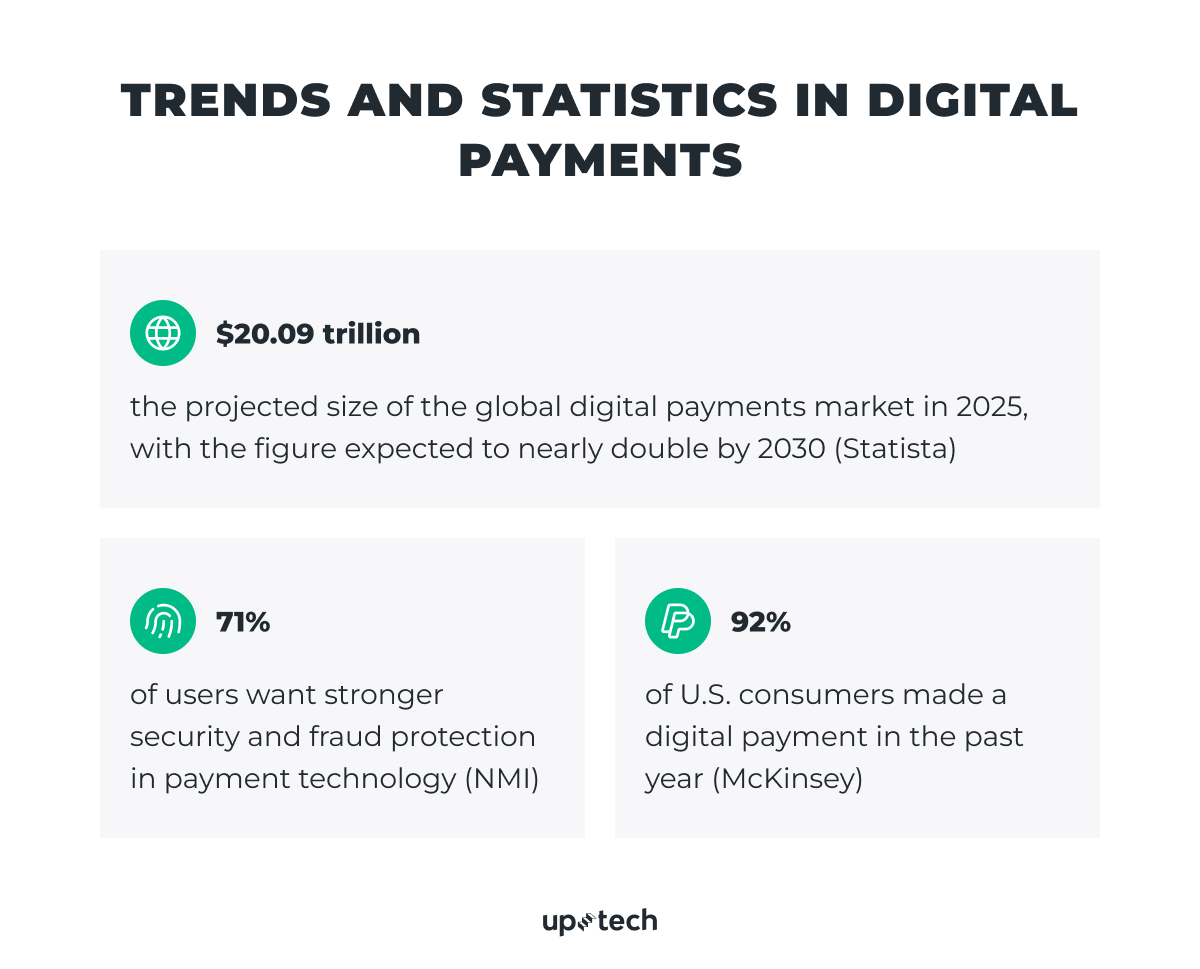Internet shopping, digital deposits, and mortgage applications on the web are only possible because of one element: the online payment system.
When starting any business (like building a neobank, an online shop, or even a mental health app), chances are high that you will have to integrate a payment system for your website. If you refuse to do it, you will likely lose many customers to competitors.
But how to create a website with an online payment system? Should you pay for the payment service? And what if you want to integrate several payment systems? These are just a few questions that plague the minds of startup cofounders when they turn to software development.
In this article, I will highlight what an online payment system is, how to create a website with an online payment system, and how to choose the right type of payment system for your website.
Let’s start!

What is a Payment System?
A payment system is a complex of software and telecommunication technologies designed to process cash-free payments. The structure of the payment system includes:
- Payment providers
- Banks
- Central regulating institution
- Processing centers and tech infrastructure providers
All these elements interact with each other under specific protocols, agreements, and legal regulations.
The most extensive international payment systems are Masterсard, Visa, American Express, Diners Club International (US), UnionPay (China), and JCB (Japan). These are the payment processing solutions of the first generation that began their activity inside their own country, but now operate worldwide. T
The second generation of online transaction services includes non-banking payment systems like PayPal. These providers operate via the Internet and work with electronic money or cryptocurrencies.
4 Types of Payment Systems
As a business owner, you have a wide range of options among the formats of payment platforms. For example, online payments on your website can be processed via:
- Internet acquiring;
- Payment gateways;
- Operators of e-payments;
- Aggregators.
Which option to choose will depend on your business's requirements and your target audience's needs.

Internet acquiring
Internet acquiring is a classic payment system that transfers money from the buyer to the seller via a protected processing center. The main feature of this method is that the payment is carried out via a plastic card, without cash withdrawal. Internet acquiring is used in both traditional banks and fintech companies.
- The pro: This is the safest method of payment transfers, using 3D-Secure and data encryption.
- The con: Agreeing with an internet-acquiring service is only available for legal entities.
Payment gateways
Payment gateways are intermediaries that redirect the transaction to the bank for processing.
- The pro: Gateways are not linked to banks or wallets. They can be used not only on websites but also on mobile. Strong data encryption.
- The con: Making a contract and agreeing on all the terms takes much more work than with other services.
Example: Opayo, owned by Evalon, is one of the most popular payment methods in the UK and Ireland. The service uses the Regulatory Technical Standards (RTS) to provide maximum data protection.
Operators of digital money transfers
A digital wallet is an alternative to a banking account. Yet, the concept of operation is quite similar. You will have to contract with the operator and integrate the payment system into your website.
- The pro: This is the easiest method for customers, independent of the geographical location.
- The con: You can only transfer a fixed amount of money for a certain period.
Example: Wise is the most popular payment system based on the e-money technology. Integrating Wise into the website is much easier and includes most of the CMS (Content Management System) functionality.
Payment aggregators
Payment aggregators are intermediary services that, unlike the gateways, first receive the customer’s money and then transfer it to the point of destination.
- The pro: Payment aggregators are easy to integrate.
- The con: You can pay double fees (to the bank and the aggregator), and the data protection can be weak.
Examples: Square is a payment aggregator with well-known POS (Point-of-Sale) solutions that help businesses accept in-person and online card payments.
Another famous payment aggregator, Stripe, offers a suite of online payment processing tools that developers and businesses can use to integrate payment systems into their websites or mobile applications.
How to Create a Website with Online Payment in 6 Steps
Now that we understand what a payment service is and how it functions, let's explore the critical phases of creating a website with online payment capabilities. Since integrating a payment system is a key step in this process, we will mainly focus on it.
Here are 6 steps to effectively add the payment system to your website:

Step 1. Build a website
Before integrating an online payment system, you must have your website up and running. In this guide, we assume that you already have a website in place and will focus on the integration of the payment system.
However, if you haven't built your website yet, here are two paths you can take:
Web builders
Numerous website builders and platforms are available that provide you with the capability to create a website yourself, even with little to no tech expertise. Such platforms offer user-friendly interfaces and customizable templates to get you started.
Examples of popular website builders include:
- WordPress – a flexible and widely used solution, with thousands of plugins for different needs.
- Wix – a beginner-friendly tool with drag-and-drop editing and customizable templates.
- Squarespace – a solution that has sleek, design-focused templates and is often favored by small brands and creatives.
Web builders provide the following pros:
- Easy to set up
- Fast deployment
- Available built-in payment options
However, there are certain cons of this approach:
- Limited customization
- Scalability challenges
- Slower load times
- Weaker SEO performance
- Lower security
Custom website development
If you prefer a more tailored solution or need advanced features from the get-go, consider hiring web developers. They can create a website that meets your specific requirements, potentially including an integrated payment system right from the start.
Key advantages of custom websites include:
- Unlimited customization
- Ability to integrate any payment system
- Scalability as your business grows
- Optimized performance and SEO
- Higher security
Potential drawbacks to consider:
- Development takes more time before launch
- Higher upfront costs compared to template-based builders
Keep in mind that the detailed process of building a website is beyond the scope of this article, but these initial steps should guide you in the right direction.
Step 2. Clarify your requirements
Okay, let's consider that your website is set up. Your next step will be to list what you expect from the payment system before integrating it. For example, these can be the following points:
Integration and customization
The company should provide options for easy and comfortable integration (maybe low-code ones), for example, the “pay” button, invoicing, APIs (Application Programming Interfaces), and plugins for CMS websites. So if the size and specifics of your business require an individual approach, consider it.
Payment methods and international reach
The payment service should collaborate with the cards of the most popular systems, like Mastercard and Visa, but also Apple Pay and Google Pay. Check for support for multiple currencies and international transactions if your business works with international customers. These days, it may be good for you to check if the system works with cryptocurrencies, too.
Fees and charges
Transparency in transaction fees is crucial. Evaluate both per-transaction charges and any monthly fees to ensure they are competitive and clear, with no additional, hidden, or unexpected fees.
Tech support
Look for a payment service that provides strong tech support, like a personalized manager to help with the integration process. Responsive customer support in case of issues is a game-changer
Security and compliance
The payment service must provide strong data security with all necessary encryption and fraud prevention measures. When it comes to fintech security, the payment system should also comply with industry regulations and data privacy laws, including GDPR, to protect both your business and your customers.
Here are the key security measures.
- PCI standards are the Payment Card Industry Security Standards Council (PCI DSS) recommendations that a payment system should follow.
Among such standards are the requirements to:
- Transmit and use the sensitive card information securely
- Use the instruments for higher data security: encryption, monitoring, and testing
- Ensure annual check-ups of the data security system
- Tokenization is a popular method of ensuring data security. It works the following way: once the user fills in some card info in the app, it is automatically deciphered into some symbols and codes that do not make any sense to a third party. This combination of characters is called a token, and it is designed to keep the user’s info from the eyes of merchants.
- The SSL protocol is one more instrument designed to keep user data from fraud. The SSL Protocol is an internet protocol that secures all the operations on the website, including those that process payment information.
By the way, you can get a copy of our ebook that includes a fintech security checklist to help ensure your solution is fully secure. It also provides a rundown of key fintech regulations and policies relevant to both startups and established companies.
Reliability and performance
Take into account the system's uptime and performance history to check if it offers fast processing speeds for a better user experience. The system should also be scalable to handle your current transaction volume and future growth.
Among additional features, you might want to learn if the system offers such functionality as recurring payments, invoicing, or advanced fraud detection tools that could benefit your business operations. For more information about how to choose the right payment gateway service, keep reading, as we have more tips in the text.
Step 3. Explore legal regulations
Get your website ready for the payment system's integration. Make sure your website follows the rules of international payment systems and trade standards. This is very important before you initiate any collaboration with a payment system.
For example, there can be such requirements as the ones presented below.
- The website works well. All of its pages appear right and in an adequate manner.
- There is a list of goods and services that your business provides, with all the details and characteristics.
- All the certifications and licenses are on the website.
- The website gives access to such information as confidentiality policy, data protection policy, delivery terms and conditions, and money return policy.
You can learn more about the ways to remain compliant in our dedicated article about payment security and payment app development.
Step 4. Register on the payment platform’s website
The next thing you should do is register on the payment platform’s website and submit an application for the integration. At this stage, you might be ready to provide all the basic information about your company:
- Country of registration
- Personal Entity/Legal Entity
- Individual Contractor
- IBAN
- Website and contacts
- Any accompanying documents
Step 5. Choose the method of integration
The payment platform you are about to use on your website provides a list of integration methods. Below, we have rounded up a few popular options.
- Online invoicing. With this method, you can generate and send digital invoices directly to customers via email or social media links, eliminating the need for a traditional checkout system. Online invoicing works best for businesses that are active on social media.
- Payment button. Ideal for simple websites, this method implies the integration of a clickable button that redirects users to a payment gateway, making transactions simple and quick with minimal navigation.
- Specific payment module. These are pre-built payment modules that often come as plugins that can be added to sites built on CMS platforms like WordPress or Shopify.
- API Integration (for complex websites). This integration method connects a website’s backend to a payment gateway provider’s system using a set of programming protocols. It lets your website send and receive data directly with the transaction payment system. API integrations work best for those who seek customizable payment processes.
Step 6. Add a payment method to a website
Here comes the most exciting part — you finally add the chosen payment method to your website after having selected the appropriate payment gateway options and chosen the integration method. The implementation of these methods on your website means that you must configure each payment option to coordinate well with your site's functionality and user interface.
After the implementation, you should run tests for each payment method. For this, you can utilize a Test or Sandbox environment to simulate transactions. By doing so, you will verify not only the technical integration but also the user experience.
Given the technical complexities involved in the whole process, it might be beneficial to consult with software development experts. At Uptech, we have built different fintech products, including cases like Aspiration, a U.S.-based platform combining banking with ethical and sustainable financial tools, and an investment app that helps users receive licensed financial advice on spending, investing, and tax management in one place.

In our project with Sprent, a delivery app popular in Saudi Arabia, the task was to make payments easier and more secure for users. We achieved this by adding HyperPay, a top payment service, allowing easy and secure credit card transactions within the app.

Feel free to contact us and get a free consultation on how to add a payment option to a website.
Okay, now that you know in general how to set up an online payment system, let’s take a closer look at the aspects of choosing the right payment system for your website.
How to Choose the Payment System for Your Website?
Before choosing the system to work with, you must figure out if it’s a fitting candidate. So here are 4 points to check when selecting a payment system for your website:

Know your users
The main goal of payment systems is to alleviate the payment process for customers. So to bring value to users, you need to take into account two factors:
- The geographical location of your target audience;
- The needs of your prospective customers.
To bring value to your users, you need to carry out marketing research. Which payment provider is popular in your region and supported by the banks in the targeted country? For example, the Amazon Pay service is gaining momentum in the US right now, with 35% of digital shops providing Amazon Pay to their customers.
Even the lifestyle of your target audience, as well as other factors like their age, can be a decisive factor in choosing the payment system. Despite the region, your customers can be more comfortable using the classic PayPal or Masterpass – the perfect option in case your customers have to manage many cards simultaneously.
Generational research backs this up:
- Gen Z values cash but also embraces BNPL services for larger purchases.
- Millennials prefer mobile wallets and peer-to-peer options such as PayPal, Zelle, and Venmo.
- Gen X looks for one-click convenience and contactless payments, both online and offline.
- Baby Boomers have the highest disposable income and are increasingly open to simple digital methods, even though many still use cash or checks.
To understand your users’ needs better, the Discovery Stage should definitely become the main part of the website development process. During the Discovery, the team usually:
- Explores the market;
- Learns the users’ habits, desires, and problems;
- Comes with a solution and tests it with potential users.
To learn more about what value Discovery Phase can bring to your business, read our dedicated blog post.
Count potential expenses
This factor is probably more apparent. Before integrating a payment system, you must first assess all potential expenses. In this sense, different platforms offer different formats: some payment systems take a fixed percentage of the payment, while others can be free under certain circumstances.
Moreover, the payment policy of all services tends to change quite often, so before choosing one, check out the details on the official website.
Assess the complexity of payment systems integration
Almost all payment services have modules for connection to popular CMS or APIs. Many payment providers, especially big ones, even offer their professionals the benefits of integrating online payment systems.
However, you can expect constant technical support from your provider. You may be disappointed when working with smaller companies. The fewer customers a provider has, the more likely the integration process will be troublesome.
Think of the speed of payments you need
This is very pleasing when customers can pay for the order with a click. And it is even better when you can withdraw this money. For example, it may be effortless to withdraw money from your local payment providers, but it may be harder to do so when working with international systems. So this research is a must-have.
Uptech’s Note: You can integrate the payment system directly into your website or use the aggregator’s service. While the second option is cheaper, it can only work as a bargain if your business is small.
However, when your business starts scaling, that’s where the problems can begin. Our recommendation is to choose a single payment system that will be comfortable for your customers and expand the website's functionality with a few online payment methods.
Should You Consider Creating an Online Payment System for Your Website from Scratch?
Integrating an online payment method is one side of the coin. Another question you might have been asking yourself is — whether you should create an online payment system itself. Well, there are certain potential benefits and challenges to weigh before actually starting to make any movements toward this initiative.
Pros of creating your own online payment system
- No vendor lock-in: You have complete independence from third-party payment services.
- Custom-made features: You are granted the ability to integrate specific features that match your business needs.
- Better user experience: Made-to-order payment process offers a much better experience for your users than if you simply integrate existing systems.
- Extra profits: In the long run, you can monetize the payment gateway by offering it to other businesses.
Cons of building your own payment gateway
- Development and maintenance costs: You inevitably deal with high initial investment and ongoing expenses for upkeep and improvements.
- Slower time to market: Unlike integrating existing solutions, building one from scratch will be a long journey.
- Responsibilities for functionality and compliance: You must also ensure constant functionality, security, and regulatory compliance, which can be resource-intensive.
Despite what path you choose (to integrate an existing payment method to your website or build a unique system from scratch), the necessity to ensure high security remains unchanged. So let’s talk about it a bit.

Interesting Digital Payment Trends and Statistics
The digital payment domain has been gaining more and more value over the years. Here are the statistics that speak to this fact.

According to Statista, the global digital payments market is projected to hit US$20.09 trillion in 2025 and nearly double to US$38.07 trillion by 2030, growing at a CAGR of 13.6%.
With such compelling numbers in mind, big businesses have no choice but to adapt. The Worldpay Global Payment Report highlights the ongoing shift away from cash, projecting a -2% CAGR from 2024 to 2030, as the simplicity, convenience, and security of digital payments continue to win consumer favor.
A recent BlueSnap survey shared that 48% of respondents think they've lost up to 10% of their money from other countries because their payment services didn't have the right options. This only highlights the importance of digital payments and an ongoing trend for their adoption.
Where do such numbers come from? Here are some trends that are pushing the statistics up.
Consumers want to have more control over their spending. The global economic crisis and pandemic forced users to shift to digital management of their savings.
Cash is going digital. According to the McKinsey research, roughly nine in ten consumers in both the U.S. and Europe reported making a digital payment in the past year, with U.S. adoption reaching a record 92%. In-store use of digital wallets continues to rise as well: They climbed from 19% in 2019 to 28% in 2024. Even traditionally cash-heavy countries such as Germany and Italy now show strong signs of wallet adoption.
The biggest concern for digital payment users is security. According to NMI’s 2025 survey, 71% of consumers want stronger security and fraud protection in payment technology, while 64% cite data breaches as their top concern.
However, for 57% of users, traditional banks are still a preferable way of making transactions due to personal attitude and service. So it can be concluded that customer service is the most significant advantage that your digital payment website can provide to a user.

Uptech is here to offer a helping hand to you in building a website with an integrated payment system. We have ample experience building products with an integrated payment system. For example, in cases like Sprent and Rivaltz, we chose the proper payment system and provided as many payment options for the user as needed.
Contact us to learn what it takes to integrate a payment system for your website.




































































































